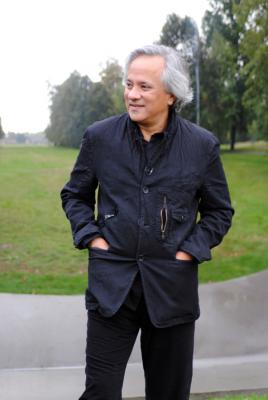The £120,000 Praemium Imperiale is a global arts prize awarded annually by the Japan Art Association. Since its inauguration in 1989, it has become an internationally important benchmark honour for the arts.
Six nomination committees, each chaired by an International Advisor, propose candidates in five fields: Painting, Sculpture, Architecture, Music and Theatre/Film. This year Anish Kapoor and Bill Viola were the winners of the visual arts awards. Kapoor is an imaginative and creative British sculptor, who has been putting ‘spectacular’ artwork in the public domain for forty years. His sculpture is “an ongoing investigation about the nature of objects and the emotions this prompts in each viewer at a given moment.” His works are frequently simple, curved forms, usually monochromatic and brightly colored. They are awesome in their size and challenge our perceptions, often through scale, reflective surfaces or distortions.
He was born in Mumbai in 1954, and grew up in India. He moved to London to study at Hornsey College of Art and Chelsea School of Art and Design. In his early career, he was fascinated by pigment to cover the works and floor around them. His later works are made of solid, quarried stone, many with carved aperture, alluding to dualities such as earth-sky, matter-spirit, body-mind. More recently in works like Sky Mirror (2001) or Cloud Gate (2004) in Chicago, he uses mirror-like surfaces to reflect or distort the viewer and the surroundings.
His latest piece is Leviathan (2011), an immense piece first exhibited in the Grand Palais in Paris. Kapoor says: “I see it as one of the principle jobs of art and the artist to make things that in spite of all rationality remain mysterious.” Bill Viola is one of the world’s leading video artists whose works are often referred to as “moving paintings”. Early on, he saw the potential of creating a new form of contemporary art combining images, movement and sound to express the human condition in a new way.
Bill Viola was born in New York in 1951 and studied visual art and electronic music at Syracuse University. Since his first public exhibition outside the university in 1972 (“St Jude Invitational,” Santa Clara, California with Wild Horses) his works have been exhibited all over the world. In 1995 he represented the US at the 46th Venice Biennale. Other notable exhibitions include Bill Viola: A 25-Year Survey organized by the Whitney Museum in 1997, New York, Bill Viola: The Passions first shown in 2003, and Bill Viola: Hatsu-Yume (First Dream) at Mori Art Museum in Tokyo in 2006.
His works are highly original and have included videotapes, video installations, sound environments, and works for television broadcast. He often uses the elements of fire, water and light in his work to explore the themes of birth death and rebirth. In 1980, Viola married Kira Perov and they began a lifelong artistic collaboration. Viola says that the death of his mother and his subsequent work The Passing (1991) was a turning point. “That was the moment I understood art. Everything became real, and I realized that my video work as an artist and my private life at that time were the same. It changed my life dramatically.” Viola is currently in production for two video chapels in St. Paul’s Cathedral in London, to be completed in 2012. Previous UK winners of the awards established in 1989 have included the architects Zaha Hadid, Richard Rogers, Norman Foster and James Stirling and visual artists Richard Hamilton,David Hockney and Bridget Riley. Photo © ArtLyst
Anish Kapoor and Bill Viola Win Japan’s Praemium Imperiale Award

